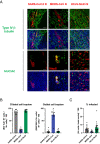Infection of primary nasal epithelial cells differentiates among lethal and seasonal human coronaviruses
- PMID: 37023127
- PMCID: PMC10104492
- DOI: 10.1073/pnas.2218083120
Infection of primary nasal epithelial cells differentiates among lethal and seasonal human coronaviruses
Abstract
The nasal epithelium is the initial entry portal and primary barrier to infection by all human coronaviruses (HCoVs). We utilize primary human nasal epithelial cells grown at air-liquid interface, which recapitulate the heterogeneous cellular population as well as mucociliary clearance functions of the in vivo nasal epithelium, to compare lethal [Severe acute respiratory syndrome (SARS)-CoV-2 and Middle East respiratory syndrome-CoV (MERS-CoV)] and seasonal (HCoV-NL63 and HCoV-229E) HCoVs. All four HCoVs replicate productively in nasal cultures, though replication is differentially modulated by temperature. Infections conducted at 33 °C vs. 37 °C (reflective of temperatures in the upper and lower airway, respectively) revealed that replication of both seasonal HCoVs (HCoV-NL63 and -229E) is significantly attenuated at 37 °C. In contrast, SARS-CoV-2 and MERS-CoV replicate at both temperatures, though SARS-CoV-2 replication is enhanced at 33 °C late in infection. These HCoVs also diverge significantly in terms of cytotoxicity induced following infection, as the seasonal HCoVs as well as SARS-CoV-2 cause cellular cytotoxicity as well as epithelial barrier disruption, while MERS-CoV does not. Treatment of nasal cultures with type 2 cytokine IL-13 to mimic asthmatic airways differentially impacts HCoV receptor availability as well as replication. MERS-CoV receptor DPP4 expression increases with IL-13 treatment, whereas ACE2, the receptor used by SARS-CoV-2 and HCoV-NL63, is down-regulated. IL-13 treatment enhances MERS-CoV and HCoV-229E replication but reduces that of SARS-CoV-2 and HCoV-NL63, reflecting the impact of IL-13 on HCoV receptor availability. This study highlights diversity among HCoVs during infection of the nasal epithelium, which is likely to influence downstream infection outcomes such as disease severity and transmissibility.
Keywords: MERS-CoV; NL63; SARS-CoV-2; human coronavirus; nasal epithelium.
Conflict of interest statement
The authors have organizational affiliations to disclose, S.R.W. is on the Scientific Advisory Boards of Immunome, Inc., and Ocugen, Inc., consulted for Merck and Pfizer. N.A.C. consults for GSK, AstraZeneca, Novartis, Sanofi/Regeneron, and Oyster Point Pharmaceuticals, has US Patent "Therapy and Diagnostics for Respiratory Infection" (10,881,698 B2, WO20913112865), and a licensing agreement with GeneOne Life Sciences.
Figures








Update of
-
Infection of primary nasal epithelial cells differentiates among lethal and seasonal human coronaviruses.bioRxiv [Preprint]. 2022 Oct 18:2022.10.17.512617. doi: 10.1101/2022.10.17.512617. bioRxiv. 2022. Update in: Proc Natl Acad Sci U S A. 2023 Apr 11;120(15):e2218083120. doi: 10.1073/pnas.2218083120. PMID: 36299422 Free PMC article. Updated. Preprint.
References
-
- Kesheh M. M., Hosseini P., Soltani S., Zandi M., An overview on the seven pathogenic human coronaviruses. Rev. Med. Virol. 32, e2282 (2022). - PubMed
Publication types
MeSH terms
Substances
Grants and funding
LinkOut - more resources
Full Text Sources
Medical
Miscellaneous

